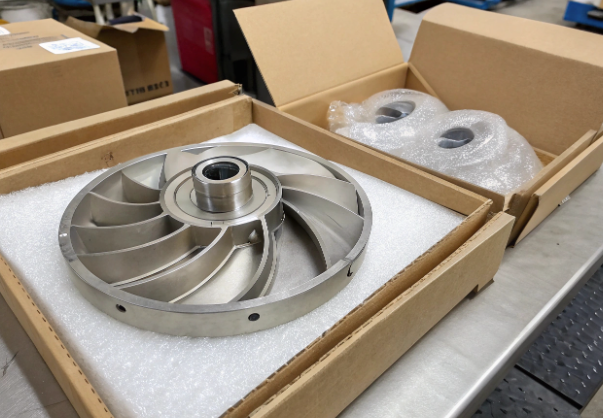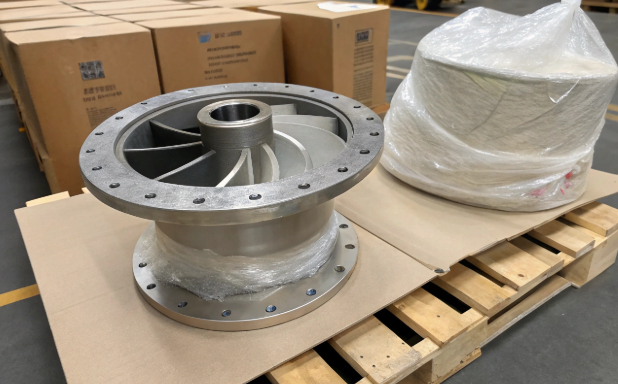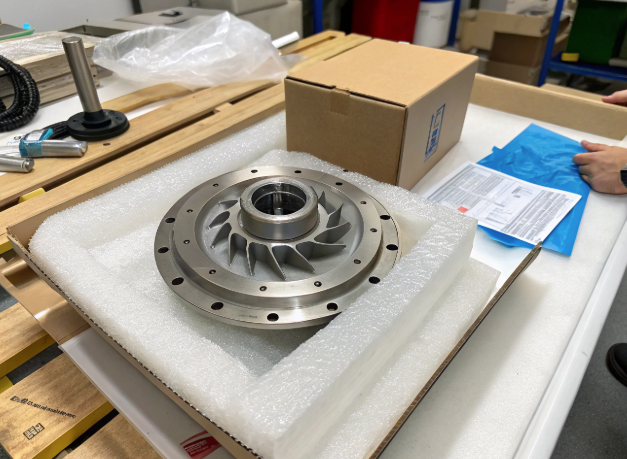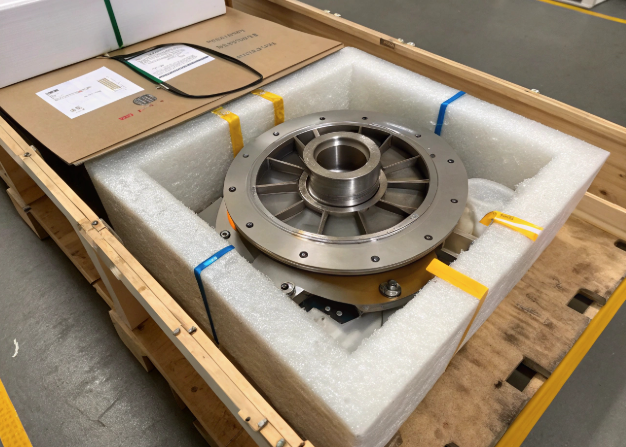Vacuum pump impellers are critical components in industrial systems, requiring careful handling during packaging and transportation to ensure their performance and longevity. Exposure to moisture and dust can lead to corrosion, contamination, or mechanical damage, compromising the impeller’s functionality. This guide provides a detailed, technical, and systematic approach to preventing moisture and dust ingress during the packaging and transportation of vacuum pump impellers, ensuring they reach their destination in optimal condition.
Understanding the Importance of Moisture and Dust Protection
Vacuum pump impellers operate in environments where precision and cleanliness are paramount. Moisture can cause rust or corrosion, particularly on impellers made of steel or other metals, while dust can accumulate on surfaces, leading to imbalances or blockages during operation. Effective protection during packaging and transportation mitigates these risks, preserving the impeller’s integrity for installation and use. The following sections outline specific techniques to achieve this, focusing on 材料選択, packaging methods, environmental control, and handling procedures.
Material Selection for Packaging
Choosing appropriate packaging materials is the first step in preventing moisture and dust ingress. The materials must provide a robust barrier against environmental factors while being durable enough to withstand transportation stresses.
- Vacuum-Sealed Plastic Bags: High-density polyethylene (HDPE) or multi-layer barrier films with a thickness of 0.1–0.2 mm are commonly used. These materials have low water vapor transmission rates (WVTR), typically below 0.5 g/m²/day at 38°C and 90% relative humidity (RH), ensuring minimal moisture penetration.
- Desiccant Packs: Silica gel or molecular sieve desiccants, with an absorption capacity of 20–30% of their weight, are placed inside sealed bags to absorb residual moisture. A typical requirement is 50–100 g of desiccant per cubic meter of enclosed volume.
- Anti-Static Foam: Polyurethane or polyethylene foam with a density of 30–40 kg/m³ is used to cushion the impeller and prevent dust attraction due to static electricity. Anti-static properties ensure surface resistivity is below 10⁹ ohms.
- Corrosion-Inhibiting Films: Volatile corrosion inhibitor (VCI) films release protective compounds that form a molecular layer on metal surfaces, preventing oxidation. These films are effective for up to 24 months under standard conditions (20–25°C, 50–70% RH).
- Wooden or Metal Crates: For external packaging, crates made of treated plywood (ISPM 15 compliant) or aluminum with a thickness of 10–15 mm provide structural integrity and additional protection against environmental exposure.

Packaging Process and Techniques
The packaging process must be systematic to ensure consistent protection. The following steps outline a standardized procedure for vacuum pump impeller packaging.
- Surface Cleaning: Before packaging, clean the impeller using a solvent-based cleaner (e.g., isopropyl alcohol, 99.9% purity) to remove oils, dust, or contaminants. Ensure the impeller is completely dry using compressed air at 2–3 bar pressure to prevent residual moisture.
- Application of Protective Coatings: Apply a thin layer of anti-corrosion oil (e.g., MIL-PRF-16173 Grade 2) to metal surfaces. The coating should be 0.01–0.02 mm thick to avoid excess residue that could attract dust.
- Primary Packaging: Place the impeller in a vacuum-sealed HDPE bag with desiccant packs. Use a vacuum sealer operating at 0.1 mbar to remove air and minimize moisture content. Seal integrity should be tested using a pressure decay test, ensuring no leaks above 0.1 Pa/s.
- Secondary Cushioning: Encase the sealed bag in anti-static foam cut to the impeller’s dimensions. The foam should have a compression strength of 50–100 kPa to absorb shocks during transit.
- Outer Crating: Place the cushioned impeller in a wooden or metal crate. Secure the impeller using straps or brackets to prevent movement. The crate should be sealed with weather-resistant tape (tensile strength ≥ 20 N/cm) to block dust and moisture entry.
Environmental Control During Packaging
The packaging environment plays a critical role in preventing moisture and dust contamination. The following controls should be implemented:
- Cleanroom Conditions: Perform packaging in a controlled environment equivalent to ISO Class 7 (10,000 particles ≤ 0.5 µm per cubic meter). Maintain temperature at 20–25°C and relative humidity below 40% to minimize moisture condensation.
- Air Filtration: Use HEPA filters (99.97% efficiency for 0.3 µm particles) in the packaging area to reduce airborne dust. Air changes per hour should be 20–30 to maintain cleanliness.
- Static Control: Equip the packaging area with ionizers to neutralize static charges, reducing dust attraction. Surface resistivity of work surfaces should be maintained below 10⁸ ohms.
- Moisture Monitoring: Use hygrometers to monitor humidity levels. If humidity exceeds 40%, employ dehumidifiers to maintain optimal conditions.

Transportation Considerations
Transportation exposesAgrarian impellers to varying environmental conditions, including humidity, temperature fluctuations, and mechanical stresses. The following measures ensure protection during transit.
- Sealed Transport Containers: Use containers with IP65 or higher ingress protection ratings to prevent water and dust entry. Containers should withstand pressures up to 1.5 bar and temperatures from -20°C to 60°C.
- Shock and Vibration Protection: Employ shock-absorbing pallets with a load capacity of 500–1000 kg. Vibration dampening should comply with ISO 13355 standards, limiting acceleration to 2g during transit.
- Temperature and Humidity Monitoring: Install data loggers inside containers to monitor conditions. Set alerts for temperatures above 40°C or humidity above 60% to prompt corrective actions.
- Proper Labeling: Affix labels indicating “Fragile,” “Keep Dry,” and “This Side Up” on crates. Use water-resistant labels with adhesive strength ≥ 15 N/cm to ensure they remain intact.
Inspection and Quality Control
Quality control is essential to verify the effectiveness of moisture and dust prevention measures. The following inspection protocols should be followed:
| Inspection Parameter | Test Method | Acceptance Criteria |
|---|---|---|
| Seal Integrity | Pressure decay test at 0.1 mbar | Leak rate ≤ 0.1 Pa/s |
| Moisture Content | Hygrometer measurement inside package | Relative humidity ≤ 10% |
| Dust Contamination | Visual inspection under 10x magnification | No particles > 0.5 µm visible |
| 腐食 | Surface inspection per ASTM B117 | No visible rust after 48-hour salt spray test |
Inspections should be conducted before and after transportation. Non-conformance should trigger repackaging or additional protective measures.
Handling and Storage Protocols
Proper handling and storage during transit and at intermediate facilities prevent damage to packaged impellers.
- Trained Personnel: Ensure handlers are trained in handling fragile industrial components. Training should cover static control, proper lifting techniques, and environmental awareness.
- Storage Conditions: Store packaged impellers in a dry, dust-free environment with temperatures between 15–30°C and humidity below 50%. Use pallet racking to keep crates off the floor, reducing exposure to ground moisture.
- Avoid Stacking: Do not stack crates unless designed for it, as excessive weight can compromise seals or damage the impeller. Maximum stacking height should not exceed 2 meters.
Documentation and Compliance
Comprehensive documentation ensures traceability and compliance with industry standards. Include the following in the packaging and transportation process:
- Packing List: Detail the impeller specifications, packaging materials, and desiccant quantities used.
- Certificate of Conformance: Verify that packaging meets standards such as ISO 9001 or MIL-STD-2073-1E for military-grade packaging.
- Transportation Log: Record environmental conditions (temperature, humidity) and handling events during transit.
- Regulatory Compliance: Ensure packaging materials comply with environmental regulations, such as REACH for chemical content in desiccants and VCI films.

Common Issues and Mitigation
While the above measures are robust, certain issues may arise during packaging or transportation. The following table summarizes common problems and their solutions:
| Issue | 説明 | Mitigation |
|---|---|---|
| Seal Failure | Breaks in vacuum-sealed bags allow moisture or dust ingress. | Use double-sealing techniques and perform pressure decay tests. |
| Desiccant Saturation | Desiccants reach absorption capacity, reducing effectiveness. | Use humidity indicator cards to monitor desiccant performance and replace if saturated. |
| Vibration Damage | Excessive vibration during transit causes impeller movement. | Increase foam thickness to 50 mm and use shock-absorbing pallets. |
| Condensation | Temperature fluctuations cause moisture buildup inside packaging. | Use insulated containers and maintain stable transit conditions. |
結論
Preventing moisture and dust during the packaging and transportation of vacuum pump impellers requires a systematic approach, combining appropriate materials, controlled environments, rigorous inspection, and proper handling. By implementing vacuum-sealed packaging, desiccants, anti-static foam, and robust crating, manufacturers can protect impellers from environmental damage. Environmental monitoring, quality control, and compliance with standards further ensure the impeller’s integrity upon delivery. These techniques, grounded in technical precision, provide a reliable framework for safeguarding vacuum pump impellers throughout the supply chain.
